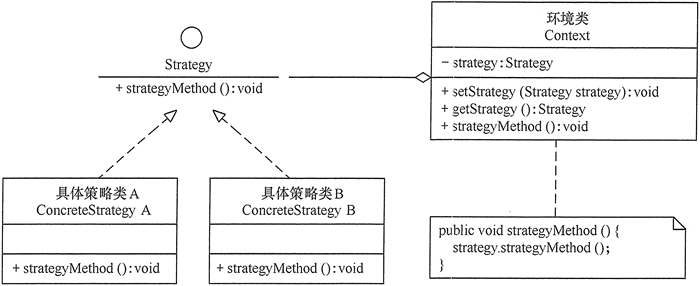定义
Define a family of algorithms, encapsulate each one, and make them interchangeable. Strategy lets the algorithm vary independently from clients that use it.
策略模式定义了一系列算法,并将每个算法封装起来,使它们可以相互替换,且算法的变化不会影响使用算法的客户。策略模式属于对象行为模式,它通过对算法进行封装,把使用算法的责任和算法的实现分割开来,并委派给不同的对象对这些算法进行管理。
结构
主要角色:
- 抽象策略(Strategy)类:定义了一个公共接口,各种不同的算法以不同的方式实现这个接口,环境角色使用这个接口调用不同的算法,一般使用接口或抽象类实现。
- 具体策略(Concrete Strategy)类:实现了抽象策略定义的接口,提供具体的算法实现。
- 环境(Context)类:持有一个策略类的引用,最终给客户端调用。
应用
基本用法
传统的可以使用工厂模式进行策略选择,实际开发一般利用spring的注入和注解进行策略选择
public interface DiscountStrategy {boolean match(String type);double calDiscount(Order order);}@Componentpublic class NormalDiscountStrategy implements DiscountStrategy {...}@Componentpublic class GrouponDiscountStrategy implements DiscountStrategy {...}@Componentpublic class PromotionDiscountStrategy implements DiscountStrategy {...}@Servicepublic class OrderService {@AutowiredList<DiscountStrategy> discountStrategyList;public double discount(Order order) {String type = order.getType();for (DiscountStrategy strategy: discountStrategyList) { // 除了简单的循环匹配,根据实际情况可考虑性能更快的策略匹配方法if (strategy.match(type)) {return strategy.calDiscount(order)}}throw new Exception('no supported strategy for order type' + type);}}
优点
- 多重条件语句不易维护,而使用策略模式可以避免使用多重条件语句,如 if…else 语句、switch…case 语句。
- 策略模式提供了一系列的可供重用的算法族,恰当使用继承可以把算法族的公共代码转移到父类里面,从而避免重复的代码。
- 策略模式可以提供相同行为的不同实现,客户可以根据不同时间或空间要求选择不同的。
- 策略模式提供了对开闭原则的完美支持,可以在不修改原代码的情况下,灵活增加新算法。
- 策略模式把算法的使用放到环境类中,而算法的实现移到具体策略类中,实现了二者的分离。
缺点
- 客户端必须理解所有策略算法的区别,以便适时选择恰当的算法类。
- 策略模式造成很多的策略类,增加维护难度。


